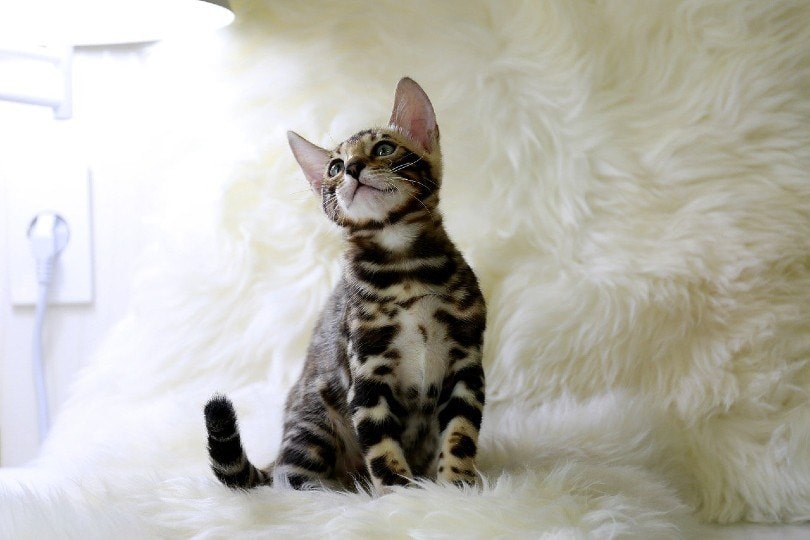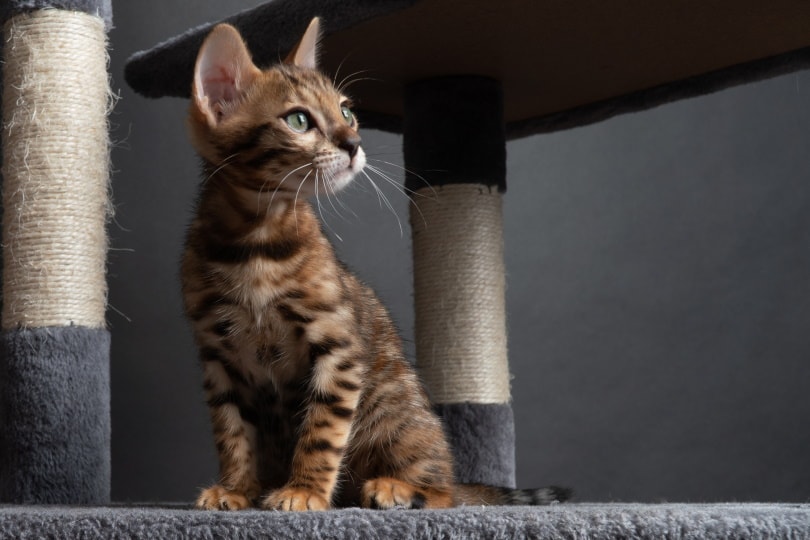
Click to Skip Ahead
Bengals are a relatively new cat breed with beautiful, spotted or marbled coats that mimic their wild cousins, the Asian leopard cat, from which they were initially bred. While the spotted coat was expected, the marbled was not. From golden to silver and white to black, we can’t help but be fascinated by their appearance.
Breed Overview
Height:
13 – 16 inches
Weight:
8 – 17 lbs
Lifespan:
10 – 16 years
Colors:
Brown spotted, seal lynx point, sepia, silver, mink
Suitable for:
Experienced cat owners
Temperament:
Intelligent, energetic, playful
Continue reading to learn more about how the marbled Bengal cat became a popular breed both in cat shows and in our homes.
Bengal Cat Characteristics
The Earliest Records of Marbled Bengals in History
The first marble Bengal cat was named Millwood Painted Desert. Jean Mill was working to create a domestic spotted Bengal in her work to help protect the wild Asian Leopard cat. According to Mill, painted Desert’s marbling looked like “drizzled caramel” and was undoubtedly beautiful, although rather unexpected.
Mill eventually worked with Dr. Willard Centerwall of Loyola University. He had also been working with Asian Leopard cats resistant to feline leukemia. Between the two and several other cats specifically chosen to create the unique Bengal patterns, Mill developed the marbled Bengal breed known today.
Because the breed was developed in the US, most Bengal cats reside in North America, but cat fanciers worldwide are beginning to appreciate their stunning exotic appearance.

How Marbled Bengal Cats Gained Popularity
When Mill showed her new marbled Bengal at a cat show at Madison Square Garden, cat show judges and attendees alike were fascinated by her gorgeous coloring and patterns. News of the new cat breed’s appearance quickly spread until demand for it increased, and Mill started working with other breeders. Today, all marbled Bengal cats are at least four generations removed from Millwood Painted Desert and her wild ancestors, although they still look like wild cats.
DNA and genome tracking has allowed breeders to work together when enhancing the most sought-after features of the Bengal breed. For most breeders, the desired traits are tri-colored marbles, which have a base color and another color that outlines the markings. New features are occurring or being enhanced through intelligent breeding, increasing their popularity.
Formal Recognition of All Bengal Cats
The International Cat Association (TIFA) formally recognized the Bengal cat as a new breed in 1986, but it wasn’t until 1991 that they gained championship status. The first marble Bengal wasn’t born until 1987, but both spotted and marbled markings are honored when judging for competition.
The Cat Fanciers Association (CFA) recognized the breed much later, in 2016, and didn’t give championship status until 2018. The CFA scoring criteria for judging are slightly different than for TIFA events, but many show-quality Bengal cats now participate in events sponsored by both organizations.
Other worldwide organizations that recognize the Bengal breed are the Governing Council of the Cat Fancy (GCCF) and the Australian Cat Federation (ACF).

Top 5 Unique Facts About Marbled Bengals
1. Some marble Bengals have a glitter coat.
A “glitter coat” adds an iridescent sheen to their fur, making them appear like glitter that shines in changing light. If you see one basking in the sun, you’ll notice how gorgeous the glitter-marble Bengals are.
2. Bengals love to swim!
Unlike most housecats, spotted and marble Bengal cats love the water. You might find them playing in their water dish and making a mess or even jumping in the bathtub for a swim!
3. Bengals are illegal in some states.
While many states don’t have specific requirements for exotic or exotic hybrid pets, others might require a license. Because Bengal cats are still considered a hybrid exotic pet, some states won’t allow you to keep one at all.

4. Sparbled Bengals are spotted and marbled.
Breeding a spotted and a marbled Bengal cat results in a beautiful “sparbled” coat pattern. While this pattern isn’t recognized for cat shows and judging, it sure does make for a beautiful cat.
5. Bengals come in all colors.
Officially recognized coat colors are brown, snow, and silver, although they can also be charcoal, blue, or solid black. Eye colors will vary based on their coat color. For example, the Snow Lynx will always have blue eyes.

Does the Marbled Bengal Make a Good Pet?
All Bengals have recent wild cat ancestors. They typically have a lot of energy and will need interactive play for exercise and mental stimulation to engage their hunting instincts. They will need ways to climb and hide, as their earlier generations would have also enjoyed these behaviors.
While more recent generations may be a bit calmer than ones in the recent past, they need experienced owners or owners who have plenty of time to devote to them with care and attention. As hunters, they were usually solitary creatures, thriving in quiet homes with fewer residents.
If you feel you are an ideal owner and have a great environment where a marbled Bengal would thrive, you should seek out an experienced breeder or cat rescue to learn more about them.
Conclusion
Marbled Bengal cats are the housecat versions of the gorgeous spotted hunters of the wild. While they exhibit some of their personality characteristics as well as their looks, they enjoy a much quieter and more relaxed life in our homes, spoiled with treats and attention. With a unique history and even more fascinating appearance, marbled Bengals are a popular breed that will become more popular with time.
See also:
- Black (Melanistic) Bengal Cat: Pictures, Info, & History
- Charcoal Bengal Cat: Facts, Origin, and History
Featured Image Credit: Ishman000, Pixabay





